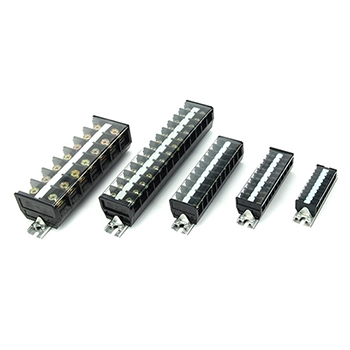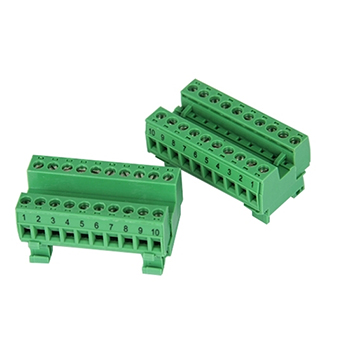Where are Terminal Blocks Used?
A terminal block is actually a connector that can be used for the interconnection of a large number of wires. There are single-layer and double-layer terminal blocks, which can be used for current, voltage, etc. A certain crimping area can ensure the reliability of the terminal connector and at the same time ensure that sufficient current can pass. The following article introduces the application of terminal blocks and the functions of different terminal blocks.
Application of Terminal Blocks
A terminal block is actually a piece of metal sealed in insulating plastic, with holes at each end through which wires can be inserted. With the development of the electronics industry, terminal blocks are used more and more widely and are currently mainly used in power control, equipment control, automation control, safety control, instrumentation, and other industries. Previously, if a terminal block was not used, the copper wire was connected directly to the screw, if there was a terminal, it would be safer, it would not come off, and its tail would be insulated.
The main application industries are: power control, equipment control, automation control, security control, and instrumentation; main manifestations:
- Control cabinet (distribution box, control box, control panel, console, DC screen, power control box);
- Components: instrumentation, lighting, controller power supply, communication control;
- Control box industry: complete sets of electrical appliances, power protection, complete sets of power generation control, power control boxes, and other control integrated systems including boxes, switches, fuses, meters, meters, signal control, and other control components, with many control lines for large currents, mainly use track type terminals;
- Components and accessories: instruments in the control cabinet, controllers, relays, ammeters, switch control systems and other components for power consumption and control, access and output terminals and independent lighting, power supplies, motors, instruments, and meters, Power consumption for automation equipment control, etc.
- The terminal block is mainly used for the connection of wires, and the terminal block is actually a piece of metal wrapped in insulating plastic. There are holes at both ends of the terminal block, and the two holes can be inserted into the wires and can be fastened or loosened with screws. For example, two wires sometimes need to be connected and sometimes disconnected. At this time, the terminal block can be used to connect or disconnect the wires at any time without welding or twisting them together, which is very convenient and quick.
- There are holes at both ends of the terminal to insert wires, and there are screws for fastening or loosening. For example, two wires, sometimes we need to establish a connection, and sometimes we need to disconnect them. At this time, we can use the terminal to connect them. It can be combined with the connection between them and can be disconnected at any time without having to weld them to learn or to be entangled.
- And it is very suitable for the interconnection of a large number of wires in China. In the power engineering industry market, there is a special terminal block and terminal box, which are full of terminal blocks, single-layer, double-layer, current, voltage, and common, and can be broken. A certain crimping area is mainly to ensure safe and reliable contact, and to ensure that sufficient current can pass.
Structure
There are two parts that make up the terminal block, one part compresses the wire, and then plugs it into the other part and solders it to the PCB board. The mechanical principle of the bottom adopts a good anti-vibration design, which ensures the long-term airtight connection of the product and the reliability of the product. Both ends of the socket can be equipped with matching ears, and the matching ears can largely ensure the alignment of the tabs, effectively ensuring that such a socket design can effectively match the mother body.
The socket can also have a locking buckle and an assembly buckle. The locking buckle locks the mother body and the socket after the installation is completed, and the assembly buckle can be more firmly fixed to the PCB board. A variety of socket designs can match different mother body insertion methods, for example horizontal, vertical, or inclined to the printed circuit board, etc., and different methods can be selected according to customer requirements. You can choose either metric wire gauge or standard wire gauge, which is the hottest terminal type on the market.
The role of different terminals
The through-wall wiring board can be installed side by side on the panel with a thickness of 1 mm to 10 mm, and can automatically adjust the distance between the panel thickness and form a terminal block with any number of poles. In addition, isolation plates can increase air gaps as well as creepage distances.
The through-wall terminal block can be firmly installed in the rectangular reserved hole on the panel without any tools, and the installation method is very convenient. The insulating material of the terminal is generally modified nylon, which has good mechanical and electrical properties. The screw is made of high-strength copper alloy, the conductor is made of electrolytic copper, and the crimping frame is made of alloy copper resistant to stress crack corrosion. The surface of these metals is also plated with tin or nickel for protection.
Copper terminals avoid the battery effect of steel metal parts and copper conductors in humid environments. There is a connection hole in the middle of the terminal, which can be connected in the center or with a side plug-in connector, and can be connected to a 4 square millimeter electrical product with a conductor voltage of 800V and a current of 41A.
How to use a terminal block?
Step One: Preparations
Before using the terminal block, you need to prepare the required tools and materials. These tools include wire strippers, screwdrivers, wrenches, and wire cutters. Materials include wires, terminals, and insulating sleeves.
Step Two: Stripping the Wires
Use wire strippers to strip the outer sheath of the wires to expose the metal wires inside. Make sure the strip length is long enough to allow the wire to be inserted into the terminal block.
Step Three: Inserting the Wires
Insert the wires into the terminal block. Make sure the wires are inserted into the bottom to ensure a good electrical connection. If needed, the terminal block can be tightened with a screwdriver or wrench to ensure that the wire is securely seated in the terminal.
Step Four: Install the insulating sleeve
Installing an insulating sleeve is very important because it protects the wires and terminals from short circuits or electric shocks. Slide the insulating sleeve over the terminal, making sure it's fully covered.

